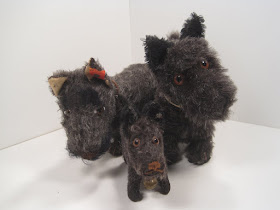Let's start hunting for clues about this hearty outdoorsman. He is 22 cm, fully jointed, and made of caramel colored mohair. His sweetly serious face comes to life with a brown hand embroidered nose and mouth and glass pupil eyes. He dons an orange felt cap with a wide brim; a green felt jacket detailed with a small collar, scalloped edging, long fringe, and a laced up front; and tall, faux brown leather boots. When he left the factory in Giengen, he had a wooden hunting rifle suspended from a leather cord tacked onto his shoulder.
This bear was produced in 1953 and 1954 and is one of Steiff's "Nimrod" Teddy bears. He was designed and manufactured in honor of the 50th anniversary of the introduction of the jointed Teddy bear as we know and love him today. Also produced at this same time, and for the same reason, was Steiff's far better known "Jackie" style Teddy bear. Jackie, known for her pink nose stitch, distinctive belly button, and impish personality, was made in 17, 25, 35, and 75 cm from
1953 through 1955 only. Like Nimrod Teddies, Jackie bears are exceptionally rare on the secondary
market given their appeal, limited production, and their brief time in the
line. A print advertisement featuring these two early, very special edition Teddy bears from 1953 is pictured here on the left. The photo is from Cieslik's Button in Ear: The History of the Teddy Bear and His Friends.
 The Nimrod bears were all based on the company's early postwar, newly redesigned "Original Teddy" pattern. This design, which featured a stockier build and shorter limbs than the company's prewar standard line bears, was produced from 1950 through 1966 in 10, 11, 15, 18, 22, 25, 28, 35, 40, 43, 50, 65, 75, and 100 cm. Overall, four Nimrod bears - in addition to the one under discussion here today - were produced. These included a 22 or 50 white version which donned a green cap, an orange felt shirt, and brown boots; a 22 cm gold version which wore a green cap, a brown felt shirt, and brown boots; and a 22 cm caramel version detailed with an orange cap, green scarf, and very tall brown "wader" style boots. All carried wooden rifles suspended from a leather cord. You can see a few more of these original Nimrod bears here on the left; the photo is from Cieslik's Button in Ear: The History of the Teddy Bear and His Friends.
The Nimrod bears were all based on the company's early postwar, newly redesigned "Original Teddy" pattern. This design, which featured a stockier build and shorter limbs than the company's prewar standard line bears, was produced from 1950 through 1966 in 10, 11, 15, 18, 22, 25, 28, 35, 40, 43, 50, 65, 75, and 100 cm. Overall, four Nimrod bears - in addition to the one under discussion here today - were produced. These included a 22 or 50 white version which donned a green cap, an orange felt shirt, and brown boots; a 22 cm gold version which wore a green cap, a brown felt shirt, and brown boots; and a 22 cm caramel version detailed with an orange cap, green scarf, and very tall brown "wader" style boots. All carried wooden rifles suspended from a leather cord. You can see a few more of these original Nimrod bears here on the left; the photo is from Cieslik's Button in Ear: The History of the Teddy Bear and His Friends.
In addition to their well designed outfits, proper footwear, and outdoorsy personalities, Nimrod bears also have distinctive numbering on their yellow ear tags. The caramel one under discussion today is numbered 5322 N. This translates into 5=jointed, 3=mohair, 22=22 cm, and N=Nimrod. You can see this numbering on the picture here on the left. Steiffgal has seen letters after article numbers, but they usually refer to colors or gender of an item, not its actual name. So this configuration is quite unusual.
And last but not least, what about the name Nimrod? Although Steiffgal cannot unearth anything definite about Steiff's choice of this name, she did discover that this might be a reference to an ancient biblical figure. According to scholars, Nimrod was the great-grandson of Noah, who built an ark to save all the animals during the great flood. Nimrod is personally described in the bible as "a mighty hunter."
Steiffgal hopes this discussion on Steiff's rare Nimrod Teddy bears has you on the hunt for one to add to your collection as well!
Have a question about one of your Steiff treasures? Let's talk! Click here to learn more.





















